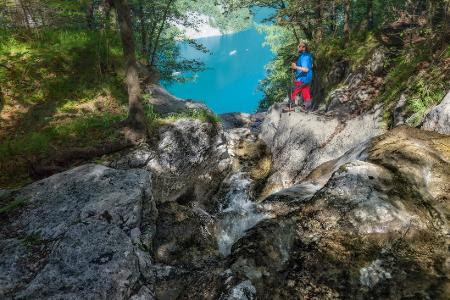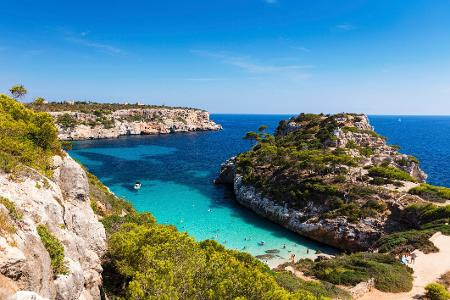The famous site draws such a frantic crowd that there’s barely space to spread a swimming towel on the narrow sand strip.
Visitors even have to queue to marvel at the Mediterranean Sea’s impressive waters.
Many give up, unwilling to spend their vacation days like this.
Crowded beaches are common in the largest Balearic Islands, one of Europe’s most popular tourist destinations.

However, this is an extreme case; for many, Instagram is to blame.
A search on the social media platform reveals tens of thousands of photos in which Caló des Moro appears deserted, its turquoise waters sparkling in the sun.
An unwary user cannot imagine how far from reality this apparent peace is.
INFLUENCERS SET TRAVEL TRENDS
Since Instagram was launched in 2010, this phenomenon has been repeated.
Following influencers’ footsteps, tourists go out hunting for the perfect vacation photo, flooding places that were either little known or less popular than they are now.

Sometimes the consequences are drastic.
For example, the Königsbach waterfall in Germany’s Berchtesgadener Land in Bavaria was forced to close to visitors when the increasing number of hikers to the local rock pools threatened the ecological balance of the site.
In polls, users recounted that they are often encouraged to emulate Instagram photos, and the platform undoubtedly plays a central role in deciding on a specific tourist destination.
Online travel agency Expedia, for example, found that half of all tourists under 40 use social media as inspiration more than traditional vehicles such as TV shows or magazines.
“Instagram undoubtedly serves as a source of inspiration for travelers on vacation,” agrees Maike Ovens of the Academy of Social Media for Travel and Tourism.
The platform stands out, especially in the search for destinations.
Nowadays, many have stopped using search engines like Google to get this information and search on Instagram through hashtags.
“That’s where they look to see what to do in the locations. If you’re not represented on Instagram, you won’t be discovered,” Ovens reinforces.
For both companies and tourism venues, bypassing the platform is impossible.
ON THE WINGS OF SOCIAL MEDIA
“Targeted communication to specific target groups, which includes all necessary vehicles, is more important than ever,” comments a spokesperson for the German Hotel and Restaurant Association (Dehoga).
Recommendations and experiences of friends and acquaintances are another important influence in choosing vacation spots.
Yet, it is no surprise that most travel and tourism agencies use Instagram to reach users.
Michael Faber, who operates three travel agencies in the German Hunsrück and Moselle regions, confirms it.
“For us, Instagram is an important communication channel to encourage a taste for travel.”
Its employees post new photos online daily, including specific suggestions like the Zillertal Valley in Tyrol.

There, the five-star Stock Resort has also long recognized the importance of the platform.
On its terrace, an imposing metal sculpture with a giant pair of wings invites guests to pose in front of the beautiful mountain panorama.
The goal is to create a backdrop against which guests are encouraged to take pictures to share on Instagram,” explains Barbara Mitterer from the hotel’s marketing section.
Just south of Italy’s Lake Garda, Natasha Bontadi, the social media lead for the Garda Trentino Tourist Board, leverages the web to spark interest in the area.
She shares little-known facts, images of secluded spots, and stunning views to attract visitors.
“We avoid talking about well-publicized areas, which are already tourism hot spots,” Bontadi explains. To help communicate the desired message, the regional body also works closely with influencers.
ARE INSTAGRAM TOURISTS OVERLY NAÏVE?
“Many locals don’t want mass tourism, but high-quality, targeted tourism,” says Julia Stubenböck, managing director of the Munich destination marketing agency Piroth Kommunikation, which plans social media-related activities, among others.
The power of images is immense. You can explain something, but you can also show it,” she says. none
The tactic often works very well, especially on Instagram, designed for sharing images.
She says that channels like this or TikTok have considerably increased the marketing options for tourism companies and destinations.
Certain target groups, especially the Z and millennial generations, are simply much more accessible via these social media platforms.
In Stubenböck’s opinion, travelers are not naively fooled by hyper-embellished online photos into believing that their vacation will be just as perfect.
The current trend is going in a different direction, and “sensitivity is growing to the fact that you can’t believe everything you see on Instagram.”

However, no evidence of such a trend can be seen in Majorca.
Caló des Moro is expected to be packed with tourists once again this summer.
Any hopes of capturing the perfect Instagram image will likely be dashed.

